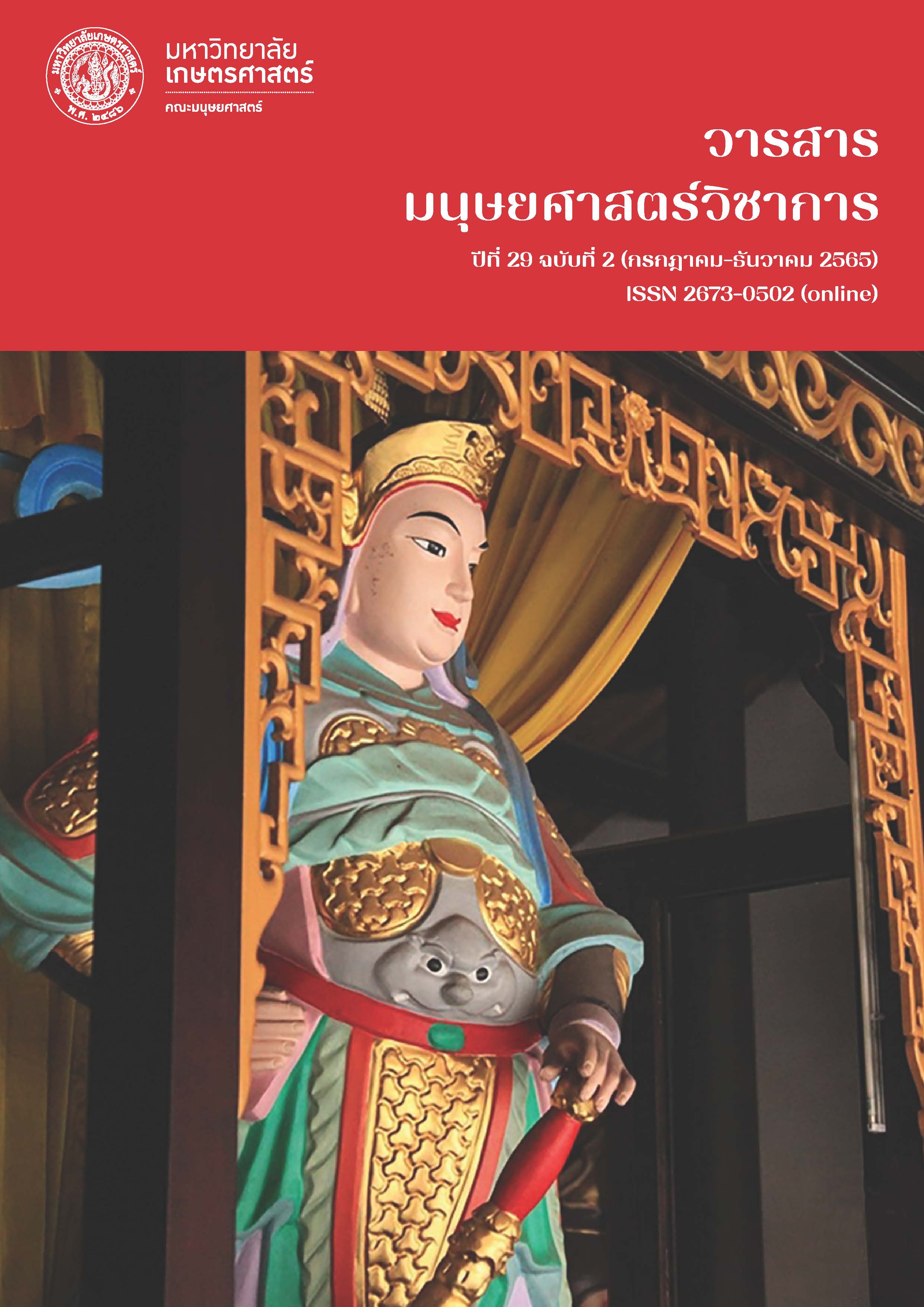Research to Obtain Guidelines for Thai-English Translation for Developing Linguistic Landscape in Tourist Attractions in Thailand
Main Article Content
Abstract
The purpose of this documentary research is to study relevant documents and literature in order to obtain guidelines for the development of a linguistic landscape in tourist attractions by using Thai to English translation. The documents and literature include 30 books and 10 research studies on the development of linguistic landscape in tourist attractions by means of translation. The research tools were 1) a table summarizing the findings from reviewing the concepts and theories from the literature in the book format, and 2) a table summarizing the findings from the previous studies review. The data were analyzed by implementing content analysis. From reviewing the concepts and theories, it was found that the guidelines for translating Thai into English for the development of linguistic landscape in tourist attractions complied with the guidelines for standardized language translation of Sanchawee Saibua (1999) based on Larson's theory (1997) regarding 1) form based translation and 2) meaning based translation, together with the public signs translation principles of Kang and Zhang (2008) and Qiannan (2012) which were 1) simple 2) clear 3) with suitable voice and 4)of standard. From the previous studies review, it was found that in the past, public relations signs have been studied and analyzed in terms of translation errors, language/s used in translation, translation strategies, and code mixing by collecting data from signs and target groups via photographs, questionnaires, observations and interviews. Therefore, the guidelines for Thai-English translation for developing a linguistic landscape in tourist attractions of Thailand were proposed as follows: data should be collected in forms of both photos and documents. Data on the needs of stakeholders in the development of the linguistic landscape should also be collected by using note taking, questionnaires, interviews, and observations. Content analysis can be employed in data analysis. Experts and native speakers should be asked to verify the accuracy of the translation. Once the Thai-English translation has been obtained, it can be taken to the research area again to verify the validity or to explore the satisfaction of stakeholders on the development of the linguistic landscape by using Thai-English translation.
Article Details

This work is licensed under a Creative Commons Attribution-NonCommercial-NoDerivatives 4.0 International License.
References
กระทรวงการท่องเที่ยวและกีฬา. (2562). สถานการณ์การท่องเที่ยวของชาวต่างชาติในประเทศไทยในไตรมาส 1/2562
และไตรมาส 2/2562. สืบค้นเมื่อ 21 พฤศจิกายน 2562
จาก https://www.mots.go.th/download/article/article_20191025094442.pdf.
จริยา เสียงเย็น. (2558). ภูมิทัศน์ทางภาษาจากป้ายโฆษณาในเขตอำเภอเมือง จังหวัดอุดรธานี. วารสารพื้นถิ่นโขง ชี มูล, 1(2),13-36.
ดียู ศรีนราวัฒน์ และชลธิชา บำรุงรักษ์. (2558). ภาษาและภาษาศาสตร์. กรุงเทพฯ: มหาวิทยาลัยธรรมศาสตร์.
ดวงตา สุพล. (2541). ทฤษฎีและกลวิธีการแปล. กรุงเทพฯ: ภาควิชาภาษาอังกฤษ คณะอักษรศาสตร์
จุฬาลงกรณ์มหาวิทยาลัย.
ถนอมจิตต์ สารอต และสราวุฒิ ไกรเสม. (2562). ความเป็นพหุภาษาในชุมชนเมือง: กรณีศึกษาความสัมพันธ์ระหว่าง
ภูมิทัศน์ทางภาษากับธุรกิจการค้าย่านนานาฝั่งเหนือ. สืบค้นเมื่อ 21 พฤศจิกายน 2562
จาก https://lc.mahidol.ac.th/lcjournal/FullPaper/JLC38-1-Thanomjit-SR.pdf.
นเรศ สุรสิทธิ์. (2551). เทคนิคการแปล. กรุงเทพฯ: พี. เอส. เพรส.
นิยม อานไมล์. (2560). การแปลเบื้องต้นสำหรับครูสอนภาษาอังกฤษ. บุรีรัมย์: มหาวิทยาลัยราชภัฏบุรีรัมย์.
ประดิษฐ์ นารีรักษ์. (2561). การศึกษาวิเคราะห์ข้อผิดพลาดในป้ายประชาสัมพันธ์ภาษาอังกฤษในพื้นที่อำเภอเมือง
จังหวัดกำแพงเพชร. สืบค้นเมื่อ 21 พฤศจิกายน 2562 จาก https://arit.kpru.ac.th/ap/e-dcms//contents/catalog/ 20191115135806.pdf.
ผ่องศรี ลือพร้อมชัย. (2559). การแปลให้เก่ง: คู่มือนักแปลมืออาชีพ. กรุงเทพฯ: สมาคมผู้จัดพิมพ์และผู้จำหน่ายหนังสือ
แห่งประเทศไทย.
พิมพันธุ์ เวสสะโกศล. (2558). การแปลภาษาไทยเป็นภาษาอังกฤษ. กรุงเทพฯ: มหาวิทยาลัยธรรมศาสตร์.
พุทธชาด ลิ้มศิริเรืองไร. (2560). การพัฒนาป้ายและแผ่นพับประชาสัมพันธ์ด้วยการแปลภาษาไทยเป็นภาษาอังกฤษ
เพื่อการท่องเที่ยวที่ปราสาทพนมรุ้งและปราสาทเมืองต่ำจังหวัดบุรีรัมย์. วารสารการแปลและการล่าม, 2(1),
-105.
ภิญญพันธุ์ พจนะลาวัณย์ และคณะ. (2560). ป้ายชื่อสาธารณะเพื่อการท่องเที่ยวในเขตเทศบาลนครลำปาง. สืบค้นเมื่อ
พฤศจิกายน 2562 จาก https://www.tci-thaijo.org/index.php/colakkujournals/article/view/116896/89822.
ยุทธศักดิ์ สุภสร. (2562). ทิศทางท่องเที่ยวไทยปี 2562. สืบค้นเมื่อ 21 พฤศจิกายน 2562
จาก http://www.ismed.or.th/PR110462(1).php.
รัชนีโรจน์ กุลธำรง. (2552). ความรู้ความเข้าใจเรื่องภาษาเพื่อการแปล: จากทฤษฎีสู่การปฏิบัติ. กรุงเทพฯ:
จุฬาลงกรณ์มหาวิทยาลัย.
ลำดวน จาดใจดี. (2550). เทคนิคการแปลไทยเป็นอังกฤษ. กรุงเทพฯ: ไทยเจริญการพิมพ์.
วีระศักดิ์ โควสุรัตน์. (2561). เที่ยวไทยทะลุ 41 ล้าน ประเมินปี 62 ต่างชาติทะลักเพิ่มทุกตลาด. สืบค้นเมื่อ 21 พฤศจิกายน 2562 จาก https://www.posttoday.com/economy/news/578456.
สัญฉวี สายบัว. (2542). หลักการแปล. กรุงเทพฯ: มหาวิทยาลัยธรรมศาสตร์.
สัญฉวี สายบัว. (2550). หลักการแปล. กรุงเทพฯ: มหาวิทยาลัยธรรมศาสตร์.
สัญฉวี สายบัว. (2560). หลักการแปล. กรุงเทพฯ: มหาวิทยาลัยธรรมศาสตร์.
สิทธา พินิจภูวดล. (2542). คู่มือนักแปลอาชีพ. กรุงเทพฯ: นานมีบุ๊คส์.
สิทธา พินิจภูวดล. (2543). คู่มือนักแปลอาชีพ (พิมพ์ครั้งที่ 2). กรุงเทพฯ: นานมีบุ๊คส์.
สุพรรณี ปิ่นมณี. (2559). แปลได้ แปลดี ทักษะการแปลสำหรับผู้เรียนในระดับมหาวิทยาลัย. กรุงเทพฯ:
จุฬาลงกรณ์มหาวิทยาลัย.
อัจฉรา ไล่ศัตรูไกล. (2560). ตำรา EN 322 จุดมุ่งหมาย หลักการและวิธีแปล. กรุงเทพฯ: มหาวิทยาลัยรามคำแหง.
อัครพนท์ เนื้อไม้หอม. (2558ก). ศึกษาและพัฒนานวัตกรรมการสื่อสารภาษาอังกฤษเพื่อการท่องเที่ยวสำหรับบุคลากร
ด้านการท่องเที่ยวที่ปราสาทพนมรุ้ง อำเภอเฉลิมพระเกียรติ จังหวัดบุรีรัมย์ (รายงานวิจัย). บุรีรัมย์: มหาวิทยาลัยราชภัฏบุรีรัมย์.
อัครพนท์ เนื้อไม้หอม. (2558ข). ศึกษาและพัฒนานวัตกรรมการสื่อสารภาษาอังกฤษเพื่อการท่องเที่ยวสำหรับ
ยุวมัคคุเทศก์ ที่ปราสาทเมืองต่ำ อำเภอประโคนชัย จังหวัดบุรีรัมย์. บุรีรัมย์: มหาวิทยาลัยราชภัฏบุรีรัมย์.
อัครพนท์ เนื้อไม้หอม และพุทธชาด ศรีพัฒนสกุล. (2558). การพัฒนานวัตกรรมที่ส่งเสริมความสามารถการใช้ภาษาอังกฤษเพื่อเตรียมความพร้อมสู่ประชาคมอาเซียนสำหรับบุคลากรด้านการท่องเที่ยวที่วนอุทยานภูเขาไฟกระโดง จังหวัดบุรีรัมย์ (รายงานวิจัย). บุรีรัมย์: มหาวิทยาลัยราชภัฏบุรีรัมย์.
Al-Athwary, A. A. H. (2014). Translating shops signs into English in Sana’ a’ s streets: A linguistic analysis. International Journal of Humanities and Social Science, 4(2), 140-156.
Baker, M. (1992). In other words: A course book on translation. New York: Routledge.
Catford, J. C. (1965). A linguistic theory of translation. London: Oxford University Press.
Claessens et al. (2007). A review of the time management literature. Retrieved August 15, 2019,
from file:///C:/Users/User/Desktop/A_Review_of_Time_Management_Literature.pdf.
Cenoz, J., & Durk, G. (2009). Language economy and linguistic landscape. In E. Shohamy & D. Gorter (Eds.),
Linguistic landscape: Expanding the scenery (pp. 55-69). London, UK: Routledge.
Guo, M. (2012). Analysis on the English-translation errors of public signs: Theory and practice in language studies. 2(6), 1214-1219.
Ji-feng, Z. (2012). On the translation of public signs from the functional perspectives. Sino-US English teaching, 9(6), 1246-1252.
Jing-jing, W. (2011). A communicative translation approach to Chinese-English translation of Public Signs.
Social and Cultural Studies, 31, 13-26.
Kang, N., & Zhang, Y. (2008). On translation of public sign expressions. Asian Social Science, 4(8), 124-128.
Ko, L. (2010). Chinese-English Translation of Public Signs for Tourism. The Journal of Specialized Translation, 13, 111-123.
Landry, R., & Bourhis, R. (1997). Linguistic landscape and ethnolinguistic vitality: an empirical study,
Journal of language and Social Psychology, 16(1), 23-49. Retrieved August 15, 2019,
from http://dx.doi.org/10.1177/0261927 X970161002.
Larson, M. (1997). Meaning-based translation: A guide to cross-language equivalence.
Oxford: Oxford University Press.
Limsiriruengrai, P. et al. (2018). Needs Analysis of Tourism Personnel for English Communicative Innovation in Sai Yao Community Silk Village, Thalunglek Sub-district, Muang District, Buriram Province.
Retrieved August 1, 2018, from http://hs.bru.ac.th/?page_id=8444.
Limsiriruengrai, P., Lertcharoenwanich, P., & Rattanawaropas, W. (2019). Development of Innovation on Tourism English Communication for Silk Village Tourism Personnel to Enhance Tourism in Sai Yao Community Silk Village, Thalunglek Sub district, Muang District, Buriram Province. Retrieved August 1, 2018, from https://dspace.bru.ac.th/xmlui/handle/123456789/5810.
Newmark, P. (1988). A textbook of translation. New York: Phoenix ELT.
Nida, E. A. (1964). Toward a Science of Translation. Leiden: E. J. Brill.
Nida, E. (1982). The Theory and Practice of Translation. Leiden: E.J. Brill.
Qiannan, M. (2012). Research on the translation of public signs. English Language Teaching, 5(4), 168-172.
Yanhong, M. (2013). Chiang Mai’s linguistic landscape in the tourist attraction areas: A study on the English language on signs. The Golden Teak: Humanity and Social Science Journal, 19(2), 59-70.


